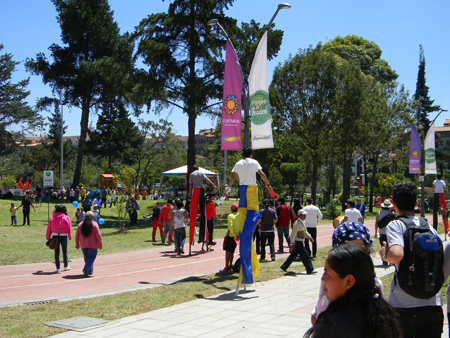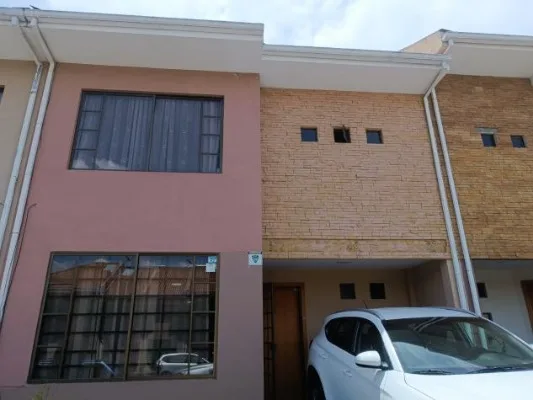What’s with all the public smooching in Ecuador and the rest of Latin America? Conservative family values mean young lovers can’t do it at home
By Scott Adamson
Parks in Latin America serve a number of purposes. They provide a green respite in an otherwise concrete jungle. They’re a space where anyone from the wealthy to the homeless can rest their legs. And, for young couples, they’re the most popular place to hook up.

Check out the action on the banks of the Rio Tomebamba.
In the park in southern Mexico where I’m writing this article, all four benches adjacent to me are currently occupied by young lovers, and another couple (whose bench I’m rudely occupying) is sprawled out in the grass. I was lucky to get a seat. I showed up early.
In Cuenca’s popular Parque de la Madre, it’s not unusual to see a dozen or more young couples in a variety of prone postures on the grass, most of them in tight embraces. In the city’s main plaza, Parque Calderon, which has no grass, the kissing takes places on several circular benches, under the shade trees. Kissing and snuggling is also on broad display on the banks of Cuenca’s Rios Tomebamba and Yanuncay.
If public displays of affection make you uncomfortable, don’t come to Latin America. Unlike the United States, there’s no room for pearl clutching here. From Mexico City to Cuenca, Medellin, Buenos Aires to Belize, making out in public is a virtual rite of passage for high schoolers and young adults.
It’s so widespread that when the city of Guanajuato passed an ordinance in 2009 banning certain forms of public displays of affection, or PDAs, it was met with such furor that the law had to be suspended days later. Nobody has since dared to tell youngsters to “get a room.”
What’s behind this phenomenon? Why is hooking up in public so ubiquitous in Latin America, yet so rare up north?
In Oaxaca, the capital city of the state of Oaxaca and my current home, I speak with a number of young Mexicans about why making out on park benches is so popular. I might as well ask them why they are wearing clothes. “Everyone does it. It’s not a bad thing,” one 14-year-old boy says, though he insists he doesn’t participate. “Being seen in public isn’t a concern.”

Cuenca’s Parque de la Madre is also popular with young lovers..
Alexis Mendoza, 22, puts on a mischievous grin when I ask him about his experience with public fajar—a term commonly used in Mexico for making out, but is literally translated as “to swaddle.” His explanation is one I hear over and over again: “There isn’t any space in my house. There’s much more room in the park.”
Housing statistics back up Mendoza’s point. According to national census data, there are two people for every one bedroom in an average Mexican household. It’s even more cramped in the state of Oaxaca, where there are an average of 2.3 people for every bedroom. In other words, not much privacy. (Three-quarters of American homes, by contrast, have one person per bedroom or fewer.) With little personal space for young lovers in a typical Mexican home, parks have become an escape from cramped and inhospitable living quarters.
But is it just the size of Mexican households that’s forcing young couples into the open? After all, there’s a certain irony to making out in the most public of places because of a lack of privacy at home.
I ask two sisters, Alma and Herminia Martinez, both in their mid-20s, if it would be acceptable for them to bring a boyfriend home. The horror that ripples through their faces suggests this is unquestionably prohibited. “Why not?” I ask. Alma is blunt: “los papás.” Dads. “They set the rules of the house, and they’re old-fashioned, especially with daughters,” she says. “No bringing boys home.” It’s still a machisimo society, after all. And even if an individual family might not object, the power of gossip when a neighbor sees a young man accompanying a young woman home is not to be underestimated.
Another factor interviewees point to is the simple fact that it doesn’t cost anything to hook up in public. Going to the movies costs money. Cafés cost money. Dinner costs money. Few young people have cars. A park bench, on the other hand, is free.

A young couple on a Mexico City sidewalk.
But what surprises me and my American sensibilities the most is this: Many young couples make out in public because they want to be seen making out in public. “Making out in public is a way to show your popularity,” Alma says. “It’s a status thing.” For insecure high schoolers, what better way to demonstrate self-worth to your classmates than to be publicly validated as attractive? Making out in public also enables sadistic exes to show (sometimes a little too eagerly) that they’ve moved on, like the former girlfriend of a guy in Oaxaca who now, every afternoon when he’s working at the café, makes sure she’s making out with her new man in his field of vision.
Not all, or even most, couples in the parks are exhibitionists, though. Most are simply there out of convenience, Alma says. “Teenagers are more liberated. They don’t care what passersby might think.” Gerardo Rios Contreras, 30, sums it up: “It’s not what you want to do, it’s what you can do.” In other words, people don’t want to go to the park to expressly make out; people just end up making out at the park.
In Cuenca, the story is much the same. Alex Vega says there is no way he can visit his girl friend Chela at her home. “Her dad would kill me,” he said. “He doesn’t even want to meet me.” On the other hand, Vega doesn’t mind making out in public, even in heavy traffic areas. “When you’re in love the place doesn’t matter, and in Cuenca, no one bothers you when you do it.”
All this PDA is part of a concept that many people cite as a common Mexican characteristic, though one that’s equally applicable to most teenagers around the globe: doblevida, a double life. There’s one life you have with your family, and another you have with your friends. Sparkling clean sons at home are rarely as upstanding in the park.
“What if your parents catch you?” I ask. After all, public trysts aren’t exactly private. Alexis Mendoza says his parents would get mad, but that’s likely it. The Martinez sisters, though, agree that punishment would be in order. “Men don’t care at all about being seen. Women have to be a bit more worried,” Herminia says. Oaxaca has enough parks, though, that young lovers can choose one far from their homes and feel reasonably assured they won’t get caught.
There are two other factors that nobody I speak with points to as causes of PDA in Mexico: Catholicism and personality.
Mexico is a much more religious country than the U.S., which could easily contribute to parents’ notions of sexual morality. However, when I ask each person if religion played a role in why they couldn’t bring boyfriends or girlfriends to the house, I’m invariably met with the same answer: no. Mendoza says it “would upset my parents if I brought a girlfriend home,” but “not because of religion, just because of their morals.”
The second non-factor is the notion that Latino culture is more heated and passionate than other cultures. (See this controversial cover from the Economist for the most recent example.)
A few studies show why this popular idea is largely a myth. In 2015, two sociologists at the University of Pennsylvania, Elizabeth Vaquera and Grace Kao, examined levels of PDA among couples of various ethnicities in the U.S. If the notion of inherent passion were true, one would expect to find higher levels of PDA among Latino couples. However, the researchers found precisely the opposite. Latinos in the U.S., they found, were considerably less likely than white couples to be publicly affectionate.
A similar study at the University of Wisconsin-Milwaukee compared levels of public contact between Latino and white couples in an American mall to test the notion that Latino culture is more affectionate. This idea is not only a popular stereotype, but one that is frequently cited in academic research as well.
But, author Nancy Flores found, “Latino Non-White couples showed the exact same amount of affectionate touching as the White-American couples.” Still, Flores cautioned, “It may be that the Latinos who were observed have assimilated more to American culture than others, or that the pressure to become more American deters people from displaying certain forms of affection.” Of course, it’s important to bear in mind that these studies were conducted on Latinos living in the U.S., not south of the border.
In general, though, the data doesn’t support the notion that there is something about Latino culture that makes its members more prone to PDA. Rather, it seems far more likely that public make-out sessions are more a product of circumstance. That is, hooking up in parks is an understandable consequence of hormone-driven teenagers living in small homes with large families and disapproving fathers.
Still, each person I speak with tells me that societal mores are changing. “Everything is more open now. It’s changed muchisimo in the last generation,” Rios Contreras says. Alma Martinez agrees: “It’s definitely more acceptable nowadays to bring someone home than before,” though many parents will still employ anti-make-out tactics, like a rule of chiflando y aplaudiendo — mandatory continuous whistling and clapping—when a young couple is in a bedroom. I ask her why things are changing. “The world is opening up,” she says. “The Internet gives kids access to answers to questions they had but didn’t want to ask their parents.”
So what if young lovers want to do more than smooch? That’s what the “motels” that flourish on the outskirts of many Latin American cities are for. Rooms rent by the hour there and naive tourists are advised by the next that they are not the place for a good night’s sleep.

















